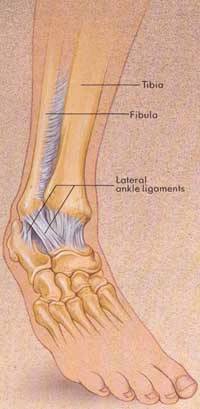Ankle Sprain
What is it?
A “sprained ankle” is one of the most common injuries in sports. It is also one of the most poorly understood, and as a result, is often under treated. A severe ankle sprain, although treated properly, can still result in chronic instability of the ankle. Fortunately, most ankle sprains are not severe and heal well with timely treatment.
Anatomy
Three essential ligaments cross the lateral surface of the ankle joint and are the most commonly affected parts of the ankle during sprains.
-
Anterior Talofibular Ligament (ATFL)
-
Posterior Talofibular ligament (PTFL)
-
Calcaneofibular Ligament (CFL)
Much more uncommonly, however, on the medial (inside) surface of the ankle joint, the deltoid ligament is injured.
Mechanisms of Injury
The injury is usually the result of the ankle turning or rolling in, commonly referred to as “going over the ankle.” In squash, this can occur with sudden pivoting or cutting movements. More often than not, the ATFL and CFL are involved.
Classification of Ankle Sprains:
-
First Degree: Most common and often neglected. The ligaments are stretched, not torn. There may be minimal to mild swelling and no instability. This patient usually treats themself and simply puts up with a sore ankle for a week or so.
-
Second Degree: Ankle ligaments are partially torn and bleeding into the surrounding soft tissue occurs, resulting in ecchymosis (bruising and discoloration). Swelling and pain may be very minimal initially and gradually worsen over the next few days peaking within a week. This degree of tear requires varying degrees of immobilization and usually 3-6 weeks of rest before the person can resume activities.
-
Third Degree: Most severe and ominous. Represents complete disruption of at the ATFL, CFL, and sometimes the PTFL. The ankle is unstable. X-rays are normal. Healing requires 8 to 10 weeks.
Treatment
In its more mild forms, the best treatment for sprained ankles is known as “RICE”. This acronym stands for Rest, Ice, Compression, and Elevation. The rest is quite self-explanatory and consists of non-weight bearing with crutches. The ice should be should be applied for the first 72 hours as much as can be conveniently performed in order to keep the swelling down. Compression consists of a tensor bandage which will help to limit the swelling, although occasionally a cast is required. Elevation must be performed to help keep the swelling down. This period of compression and elevation can often take up to 2-3 weeks if the sprain is bad enough. As the pain subsides, an exercise program with physiotherapy can be started to increase the strength of the ankle and foot muscles. The advice of physiotherapists or similar knowledgeable individuals should be sought for proper teaching of these exercises.
Although somewhat controversial, it is rare to operate on even severely sprained ankle injuries. In the United States, immobilization involving bracing and non-weight bearing with crutches is usually employed.
Depending upon the situation, the surgical repair for instability, whether acute or chronic, is a viable alternative and can be very gratifying.
Prevention
-
Perform stretching exercises.
-
Use proper footwear. Your shoe should have good lateral support, a relatively low heel (different from jogging shoes which have a built up heel and poor lateral stability) and rounded contours to avoid “going over.” Shoes with a higher boot top (“high cuts”) may be indicated for those with chronic instability. Lace-up ankle supports may be very helpful.
-
Avoid uneven surfaces which might include anything from your opponents foot to poor court flooring to uneven training ground.
Deciding on Surgery
If you repeatedly sprain your ankle, you may need to have your ligaments reconstructed. This will re-stabilize your ankle and allow you to return to sport without constantly worrying about re-spraining your ankle. It is a very satisfying procedure, but like all surgeries, does carry some elements of risk to it. Discuss these risks/advantages with your doctor.
